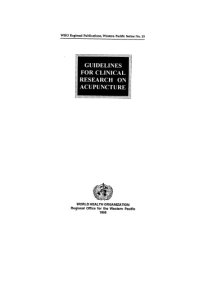
Ebook: Guidelines for Clinical Research on Acupuncture
- Genre: Medicine // Natural Medicine
- Series: A WPRO Publication
- Year: 1995
- Publisher: World Health Organization
- Language: English
- pdf
Sets out basic guiding principles for the design and conduct of clinical evaluations of acupuncture.
Noting that knowledge about acupuncture remains largely confined to anecdotal experiences, the guidelines aim to encourage the use of systematic laboratory and clinical studies as a way of validating acupuncture, improving its acceptability to modern medicine and thus, extending its use as a simple, inexpensive and effective therapeutic option. With this goal in mind, the book sets out guidelines that incorporate the established methods and procedures of scientific investigation, yet reflect the special nature of acupuncture as a discipline. The guidelines respond to both growing interest in the therapeutic applications of acupuncture and the need to validate these applications through the compilation of reliable and comparable clinical data. The main section sets out detailed guidelines for conducting clinical studies. Topics covered include the use of standard terminology and technology to ensure the reproducibility of studies, recommended qualifications and responsibilities of the investigative group, general research design and specific considerations for the design of randomized controlled clinical trials. Other study designs described include cohort studies, retrospective case-control studies, sequential trials, single subject experiments and clinical audit. A list of 25 items to be included in research protocols is provided. Annexed to the guidelines is a summary of current scientific knowledge about modes of action that might account for the effectiveness of acupuncture in pain relief and other therapies.
Noting that knowledge about acupuncture remains largely confined to anecdotal experiences, the guidelines aim to encourage the use of systematic laboratory and clinical studies as a way of validating acupuncture, improving its acceptability to modern medicine and thus, extending its use as a simple, inexpensive and effective therapeutic option. With this goal in mind, the book sets out guidelines that incorporate the established methods and procedures of scientific investigation, yet reflect the special nature of acupuncture as a discipline. The guidelines respond to both growing interest in the therapeutic applications of acupuncture and the need to validate these applications through the compilation of reliable and comparable clinical data. The main section sets out detailed guidelines for conducting clinical studies. Topics covered include the use of standard terminology and technology to ensure the reproducibility of studies, recommended qualifications and responsibilities of the investigative group, general research design and specific considerations for the design of randomized controlled clinical trials. Other study designs described include cohort studies, retrospective case-control studies, sequential trials, single subject experiments and clinical audit. A list of 25 items to be included in research protocols is provided. Annexed to the guidelines is a summary of current scientific knowledge about modes of action that might account for the effectiveness of acupuncture in pain relief and other therapies.
Download the book Guidelines for Clinical Research on Acupuncture for free or read online
Continue reading on any device:

Last viewed books
Related books
{related-news}
Comments (0)